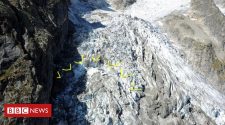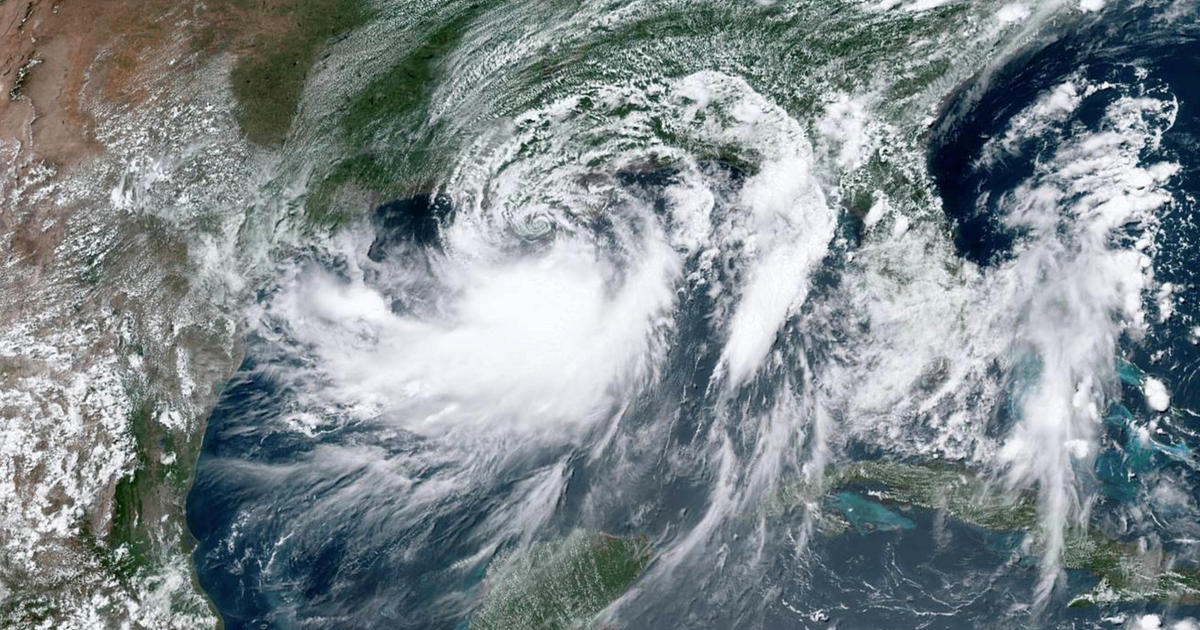Tropical Storm Barry was moving toward the Louisiana coastline Friday, and nearly 10,000 people have already been ordered to evacuate. President Trump has declared a federal emergency for the state as crews prepare for storm surge that could cause major flooding across New Orleans and surrounding areas.
The National Hurricane Center said the slow-moving storm is expected to strengthen into a hurricane as it comes ashore Saturday. Barry’s biggest threat will be rain with 10-20 inches expected to fall in parts of Louisiana and southwest Mississippi, the hurricane center said.
Some areas could see up to 25 inches of rain, the center said. Officials in New Orleans said the storm will be a test for the levees protecting the city.
The Mississippi River was expected to crest at 19 feet, just a foot below the tops of the levees. National Guard troops have been deployed around the state to help those stranded by flooding.
Friday evening, Barry was about 75 miles south-southeast of Morgan City, Louisiana, and its maximum sustained winds were 65 mph. Tracking forecasts showed the storm continuing on toward Chicago, swelling the Mississippi River basin with water that must eventually flow south again.
FAA says it’s “closely monitoring” storm
The Federal Aviation Administration issued a statement on Friday saying it was monitoring Tropical Storm Barry. “We are preparing facilities and equipment to withstand storm damage along the projected storm path so we can quickly resume disaster relief operations after it passes,” the agency said.
The statement included tips for travelers who may be impacted by the storm. The FAA advises checking with airlines about flight statuses and taking every aspect of traveling into consideration, from parking and checking in to passing through security and boarding.
A notice was issued urging drone users to avoid flying in the area and outright barring those without remote certification or exemptions from flying.
Hurricane warning in effect for parts of Louisiana
NOAA/Handout via Reuters
The hurricane center has issued a hurricane warning from Intracoastal City to Grand Isle in Louisiana, meaning hurricane conditions were expected somewhere within the area within the next 36 hours. Hurricane conditions were possible from the mouth of the Mississippi River to Grand Isle and from Intracoastal City to Cameron, Louisiana.
A tropical storm warning was issued for:
- From the mouth of the Pearl River to Grand Isle
- Lake Pontchartrain and Lake Maurepas, including metropolitan New Orleans
- From Intracoastal City to Cameron
A hurricane warning was issued for:
- Intracoastal City to Grand Isle
Tropical storm conditions were possible from east of the mouth of the Pearl River to the Mississippi-Alabama border.
Dangerous storm surge could also occur. A warning of life-threatening inundation from rising water moving inland was issued from Intracoastal City to Biloxi, Mississippi, and for Lake Pontchartrain.
Dangerous storm surge was possible from Biloxi to the Mississippi-Alabama border.
“Your preparedness window is shrinking”
While no evacuations were ordered in New Orleans, many homeowners sandbagged their property or, in the case of exposed, low-lying areas along the coast, packed up and left. Tourists crowded the city’s airport in hopes of catching an early flight and getting out of town ahead of the storm.
“This is happening. … Your preparedness window is shrinking,” hurricane center Director Ken Graham warned. He added: “It’s powerful. It’s strengthening. And water is going to be a big issue.”
The storm’s leading edges lashed the state with bands of rain for most of the day, and some low-lying roads near the coast were already covered with water Friday morning as the tide rose and Barry pushed water in from the Gulf of Mexico. While Barry was expected to arrive as a weak hurricane, just barely over the 74 mph windspeed threshold, authorities warned people not to be fooled by that.
“Nobody should take this storm lightly just because it’s supposed to be a Category 1 when it makes landfall,” Louisiana Gov. John Bel Edwards said. “The real danger in this storm was never about the wind anyway. It’s always been about the rain.”
Authorities took unprecedented precautions: The governor said it was the first time all floodgates were sealed in the New Orleans-area Hurricane Risk Reduction System. Still, he said he didn’t expect the river to spill over the levees.
NOAA/NWS
Workers also shored up and raised the levee system in places with beams, sheet metal and other barriers. The storm’s slow track meant it was likely to deliver a deluge of water.
“There are three ways that Louisiana can flood: storm surge, high rivers, and rain. We’re going to have all three,” said Edwards.
New Orleans Mayor LaToya Cantrell said the city’s pumps were working “at optimal capacity.”
CBS News’ Marc Liverman reported that some residents were taking no chances with the storm. Clarence Brocks of Phoenix, Louisiana, said he and his family were taking enough clothes for three days, along with “flashlights and good batteries and stuff like that, because that’s the routine. This area right here, you always got to evacuate.”
He said they would return after the storm, as it’s the only home they’ve ever known.
Some Louisianans choosing to stay behind
Mr. Trump’s emergency declaration frees up more federal resources and will help coordinate the response to the looming disaster. Ahead of the storm, Louisianans in low-lying areas tied up boats, stocked up on supplies, prepared sandbags and got out Thursday, “CBS This Morning” lead national correspondent David Begnaud reported from Grand Isle.
“Anytime there is a disturbance it always disturbs me,” Ken Smith said.
But some chose to stay behind. “Help people that need help, ride it out, party it up,” one man said.
Begnaud reported that Grand Isle, one of the parishes ordered to evacuate, has five permanent drainage pumps and they’ve brought in six temporary pumps to help with the expected deluge.
FEMA personnel were already on the ground in Louisiana and 3,000 National Guard members were also called in to help.
New Orleans residents brace for flooding
The storm system improvements made after Hurricane Katrina in 2005 are about to be put to the test.
In New Orleans, storms that unleashed flash-flooding Wednesday were a fresh reminder of what a deluge can do. Cantrell said drainage pumps were working, but “we cannot pump our way out of the water levels and the waterfalls that are expected to hit.”
All eyes were on the levees that protect the city. The forecasted crest was revised down on Thursday, however, and the Army Corps of Engineers said it did not expect any overtopping of the levees.
Storm surge predictions issued by the National Weather Service Friday night indicate that the Mississippi River could crest just above 17 feet — the threshold for official flood stage.



















